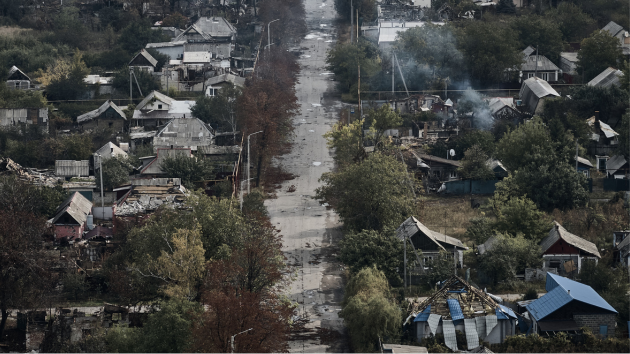Ukraine faces potential fall of Pokrovsk to Russia after 18-month battle of attrition
Written by ABC Audio ALL RIGHTS RESERVED on November 6, 2025

(LONDON) — Ukraine appears at increasing risk of losing the city of Pokrovsk, an important stronghold in eastern Ukraine where its embattled defenders have held off Russia’s grinding assaults for more than a year and a half.
The devastated city — which was home to some 60,000 people before Russia’s February 2022 full-scale invasion — has become a key focus of the Kremlin’s yearslong push to capture all of Ukraine’s eastern Donetsk Oblast, which along with neighboring Luhansk Oblast makes up the Donbas region.
Although Ukraine for now is still maintaining a defense, the fall of Pokrovsk would be one of the most serious defeats Ukraine has suffered since March, when its troops were forced to retreat from Russia’s Kursk region.
Russia has for many months been attempting to encircle Pokrovsk and neighboring Myrnohrad from the north and south. Moscow’s forces are now close to cutting off the main roads into Pokrovsk, with its two key supply routes already under fire from Russian drones making it dangerous and difficult to bring in supplies and also threatening Ukrainian forces ability to withdraw.
In recent weeks, a growing number of Russian troops have advanced into Pokrovsk, with small groups using infiltration tactics to penetrate into the heart of the city, according to both Ukrainian and Russian military analysts.
Intense street fighting is now taking place inside Pokrovsk, with Ukraine’s commander-in-chief Gen. Oleksandr Syrskyi describing the situation as “difficult.”
“The enemy in Pokrovsk is paying the highest price for attempting to fulfill the Kremlin dictator’s task of occupying Ukrainian Donbas,” Syrskyi wrote in a post to Telegram on Saturday.
Ukrainians outnumbered, under fire
Ukraine in recent days has launched counterattacks to push Russian forces back from the northern edge of Pokrovsk and keep a road there open to Myrnohrad.
Last weekend, for example, special forces troops under the command of Main Directorate of Intelligence (GUR) chief Kyrylo Budanov launched an audacious heliborne operation into territory that Russian forces claimed they already controlled. The GUR later uploaded video of the assault.
But the momentum in Pokrovsk appears to be with the attacking Russian forces. The city’s fall would be a blow to Ukrainian morale and would complicate its broader defense of the Donbas region.
There are also concerns in Ukraine that its loss could open a route for a Russian offensive towards the cities of Kostyantynivka, Kramatorsk and Sloviansk — the largest Donbas cities still controlled by Kyiv.
But military analysts who spoke to ABC News suggested that the fall of Pokrovsk alone would not necessarily imperil Ukraine’s forces holding the area.
“The Ukrainians could quite likely just as easily continue to defend outside Pokrovsk and Myrnohrad,” Pasi Paroinen of the Finland-based Black Bird Group open-source intelligence analysis organization told ABC News.
Though urban centers “usually make decent tactical defensive positions,” Paroinen added, “when you are already surrounded from three sides and your lines of communications have been cut off or are being disrupted as badly as they are right now over there, then those positions become liabilities, and they are just basically draining Ukrainian resources.”
A Ukrainian withdrawal may even improve Kyiv’s prospects, Paroinen said, assuming that new defenses have been prepared to the city’s west. If those new fortifications are not ready, “then they have a bigger problem than failing to hold Pokrovsk and Myrnohrad,” he said.
The Institute for the Study of War think tank suggested that Russia is unlikely to have the reserves to exploit Pokrovsk’s potential fall to advance rapidly to seize more of the Donbas region. Rather, Moscow’s mauled forces would likely have to continue their slow and costly forward grind, the ISW said.
Regardless, the situation is fraught for Ukrainian units still present in the city. The omnipresent threat of drones could complicate any Ukrainian retreat effort, which would likely see Kyiv’s troops attempt to break out to the west of the city using its under-fire supply routes.
If unable to retreat, large numbers of Ukrainian troops could find themselves cut off and potentially captured. To date and with the exception of the Russian siege of Mariupol in the early stages of the invasion, Kyiv’s forces have avoided being forced into mass surrender, even as they’ve gradually ceded territory in the east of the country.
The fall of Pokrovsk would also likely buoy Russian morale and send a signal that the war is going in its favor — a signal likely to be amplified by Russian state-aligned media and the Kremlin.
Moscow has amassed around 170,000 troops in the Donetsk region with a focus on Pokrovsk, according to remarks by Ukrainian President Volodymyr Zelenskyy on Friday — a signal, he said, of Russian President Vladimir Putin’s intent to capture the area.
Russia has not said how many troops it has deployed to the area. Ukrainian troops defending it are outnumbered eight-to-one, Zelenskyy said.
Visiting a command post in the Dobropillia sector — just north of Pokrovsk — this week, Zelenskyy said Ukrainian forces there are “defending Ukraine and our territorial integrity. This is our country, this is our East, and we will certainly do our utmost to keep it Ukrainian.”
Russian soldiers have already paid a high price. Ukraine’s General Staff said that, since the start of 2025, Moscow has lost some 200,000 soldiers who have been killed or wounded in Donetsk, most of them in the Pokrovsk and Kupyansk directions.
Russia does not release details about its casualties, making it difficult to independently confirm that figure. Ukrainian estimates of Russian casualties have broadly chimed with estimates from U.S. and European intelligence agencies since 2022.
A Russian victory in Pokrovsk will be welcome good news for the Kremlin as Putin maneuvers for advantage over his Ukrainian and American counterparts in anticipation of possible talks over a proposed ceasefire and eventual peace deal.
Russian Chief of the General Staff Gen. Valery Gerasimov last week sought to play up the significance of Moscow’s advance on the city, telling Putin that up to 10,000 Ukrainian soldiers were “encircled” in areas including Pokrovsk — a claim later denied by Ukrainian officials and even disputed by some Russian military analysts, and that most military observers say is currently false.
Fight or flight?
The current situation in Pokrovsk is following a similar pattern as other embattled Donbas cities like Bakhmut in 2023 and Avdiivka in 2024. In all three, Russian forces edged forward over several months at staggering human cost despite a resolute Ukrainian defense, according to figures released by Kyiv. In Bakhmut and Avdiivka, Ukrainian forces were eventually forced to abandon the cities.
Zelenskyy and his generals have been criticized by some military bloggers and analysts in Ukraine and abroad for their perceived sluggishness in ordering retreats from doomed Donbas cities.
“The Ukrainians are committing to defending these towns, I would say, for too long,” Paroinen said. “The Russians are already too deep, and I think in too many numbers inside Pokrovsk for Ukrainians to be able to throw them out.”
Ukrainian political and military officials have repeatedly said that military — not political — considerations are front of mind, framing their defense of certain cities as a means to further bleed Russia’s attacking units. Others have argued for a nimbler “defense-in-depth” approach to preserve Ukrainian lives and conserve stretched resources.
“Defense-in-depth is not something the political leadership appreciates too much,” Oleksandr V. Danylyuk — an associate fellow at the Royal United Services Institute think tank in the U.K. and the chairman of the Center for Defense Reforms think tank in Kyiv — told ABC News. “That’s why I would rather expect the government to fight for as long as they can.”
“I think that potentially, Ukraine can actually keep the ground in Pokrovsk, in the same way as the ground has been kept in Chasiv Yar, for instance,” Danylyuk — who has previously served as an adviser to top Ukrainian military and intelligence officials — added, referring to the pivotal fortress city to the northwest where Ukrainian troops have been pushed back but retain a foothold after a yearlong Russian offensive.
“I’m not quite sure if Pokrovsk is of the same importance militarily as Chasiv Yar,” Danlyluk said.
“Personally, I don’t see any real military reason to actually fight for Pokrovsk,” he said. “I understand political reasons. I understand symbolic reasons. And I believe that it is doable. It’s just a matter of price. And I’m not quite sure if we need to pay the price.”
Oleksandr Merezhko — a member of the Ukrainian parliament representing Zelenskyy’s party and the chair of the body’s foreign affairs committee — downplayed the criticism of the decision to fight for Pokrovsk.
“I guess our military philosophy is to defend a particular point till the last opportunity, but at the same time to save people,” he told ABC News. “To make the Russians lose more of their soldiers and to save our soldiers.”
But influential military figures, such as Vitalii Deineha — the well-known Ukrainian volunteer and founder of the Come Back Alive Foundation — are already calling for Kyiv to abandon the city.
“The General Staff reports to the top contain more and more lies every day,” Deineha wrote in a post to Facebook. “In fact, we have practically already lost Pokrovsk, which means that holding Myrnohrad also makes no sense.”
“We should not be afraid of rating drops, because there will be no elections: next year there will be war again. And someone will have to fight it,” he added.
Copyright © 2025, ABC Audio. All rights reserved.
 KVSP
KVSP 




